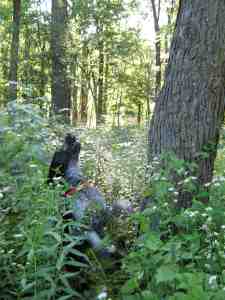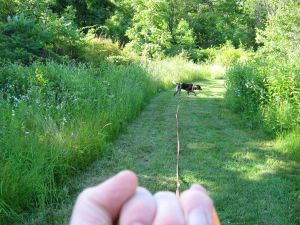Hounds are notoriously clever, strong, and stubborn, and Jane is no exception. She can open doors and climb fences, and, when given a command, she still doesn’t always reflexively obey. Instead, she seems to weigh her options. Though she’s learning that my commands are not debatable, her instincts sometimes prove stronger than my alpha status.
I do quite a bit of city walking, but I do even more on the trail. While I share my life with a dog for many reasons, one of the most important is for companionship on my daily excursions/adventures in the wild. I love nature and I love getting dirty, and dogs are all about getting filthy and running in the woods. Unfortunately, hounds love the wild so much that, given the chance, they’ll follow a scent for hours or even days. They can’t help it. Though Jane’s recall is improving, she still cannot be trusted to return to me 100 percent of the time (particularly if she’s treeing a raccoon).

Since I wanted her to be an off-leash hiking companion, Jane’s zealousness on the trail proved problematic for me. Per the recommendation of my Up North friend, Paul, I outfitted Jane with a backpack and weighed it down with water bottles, treats, and a collapsible bowl. While she looked really cool wearing the backpack, and it did weigh her down giving her a good workout and helping me maintain control over her, it ultimately proved cumbersome and kind of unnatural.
I finally hit upon the workings of a solution when I found a 30-foot leash at Mantis Pet Supplies on Michigan Ave. in Ypsi. (Please shop there. It’s a locally-owned, family-run business, and they have the best dog and cat products in town.) The 30-foot leash was great. It allowed Jane additional freedom both on the trail and in the park, and it enabled us to spend more time focusing on migrating and hunting. Unfortunately, the leash was made of cotton, so it would stiffen when wet, and it ultimately frayed and snapped. In my search for something better, I landed on the holy grail: The Best Dog Training Leash. Sold by a really cool guy in Maine, the BDTL is a whopping 50-feet long, one-inch wide (as opposed to the wimpy half-inch cotton lead), and, here’s the kicker, made of nylon. It’s practically indestructible, doesn’t freeze, doesn’t snag on stumps and rocks, and weathers the elements like Teflon. I’m not one to get excited about products, but I really can’t say enough about this awesome training lead. Jane and I have put hundreds of miles on this leash since buying it in February, and it’s still in mint shape. I love it so much, in fact, that it’s the only leash I use. On city walks, I coil it around my arm and keep her at my knee and then gradually increase her liberty when we come to a park, field, or other green space.
My goal is to eventually do away with this leash (gimme another year or two), but for now, it’s a lifesaver. It has revolutionized the way I exercise with my dog and has proved an invaluable aid in our training and bonding.

How do you keep from getting the leash all tangled up in the trees and brush? I am not a hunter either, and somehow ended up with two coon hounds, a blue tick, 2 and an abused red bone mix that’s 3. Also when your walking in the city with Jane constant need to follow scents?
Using the 50-foot leash requires constant use of both hands. You need to always be reeling it in and letting out slack in order to allow the dog as much freedom as possible and keep the leash from excessive dragging on the ground. This helps maintain physical control over the dog and avoid tangles. It requires a lot of practice, though, before you and your dog develop a solid understanding of the lead. For seamless walking, use of the leash must be accompanied by ongoing verbal commands, too. It’s not easy, but the benefits are worth it. I still use the long lead when appropriate, even after almost four years.
City walking can be challenging for the hound, too. When Jane was young I kept her in a heel whenever we walked on sidewalks and then gave her a little slack in parks and other green areas. Now that she’s older and knows my rules/expectations, I can ordinarily give her a few feet of slack on city walks. I still need to be sure, though, that I can quickly get her in a heel position whenever it might be necessary – passing pedestrians and dogs, encountering cyclists and skateboarders, etc. Again, lots of verbal reinforcement on city walks helps the dog learn the rules and know what to expect. After a couple of years of daily walking with consistent commands and expectations, you and your dog can relax a bit and shift to autopilot.
Hang in there!
I realize this is an older post of yours, but I just found it. My wife and I adopted a red bone coonhound about a month ago and will spend lots of time this winter training him for hiking in the spring. I have been nervous about his hunting instinct, but I love that you’ve been able to train Jane well enough to make it work. I can’t wait to read more about you and Jane to find training tips for our red bone (male, Lucky, about 16 months old, so the vet said).